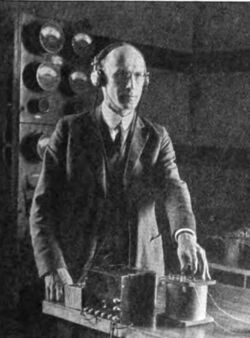John Milton Miller
Topic: Biography
 From HandWiki - Reading time: 2 min
From HandWiki - Reading time: 2 min
John Milton Miller | |
|---|---|
 Miller operating a radio amplifier | |
| Born | Hanover, Pennsylvania |
| Nationality | United States |
| Awards | IEEE Medal of Honor (1953) |
| Scientific career | |
| Fields | Electrical engineering |
John Milton Miller (June 22, 1882 – May 17, 1962)[1] was a noted United States electrical engineer, best known for discovering the Miller effect and inventing fundamental circuits for quartz crystal oscillators (Miller oscillators).
Formative years and family
Miller was born in Hanover, Pennsylvania on June 22, 1882. In 1904, he graduated from Yale University. He then obtained his M.A. there in 1907, followed by his Ph.D. in Physics in 1915.
He married Frances Riley; the couple had seven children — two girls and five boys.[2]
Career
From 1907 to 1919, Miller was employed as a physicist with the National Bureau of Standards; he then worked as a radio engineer at the United States Navy's Radio Laboratory in Anacostia, District of Columbia from 1919 to 1923, and subsequently at the Naval Research Laboratory (NRL). From 1925 to 1936, he led radio receiver research at the Atwater Kent Manufacturing Company, Philadelphia. From 1936 to 1940, he was the assistant head of the research laboratory for the RCA Radiotron Company. In 1940, he returned to NRL where he became superintendent of Radio I Division (1945), associate director of research (1951), and scientific research administrator (1952).[3]
Honors
Miller was awarded the Distinguished Civilian Service Award in 1945 for "initiation of the development of a new flexible radio-frequency cable urgently needed in radio and radar equipment which solved a desperate material shortage in the United States during World War II," and the IRE Medal of Honor in 1953 for "his pioneering contributions to our basic knowledge of electron tube theory, of radio instruments and measurements, and of crystal controlled oscillators."
References
- ↑ Although Miller's obituary in the New York Times stated that he was born on June 21, 1882, church records in Hanover, Penn. (the place of his birth) and Miller's World War I draft registration card (which he signed) stated that he was born on June 22, 1882.
- ↑ "Dr. John Milton Miller Is Dead; Radio and Electronics Specialist" (in en-US). The New York Times. 1962-05-19. ISSN 0362-4331. https://www.nytimes.com/1962/05/19/archives/dr-john-milton-miller-is-dead-radio-and-electronics-specialist.html.
- ↑ "Dr. John Milton Miller Is Dead; Radio and Electronics Specialist" (in en-US). The New York Times. 1962-05-19. ISSN 0362-4331. https://www.nytimes.com/1962/05/19/archives/dr-john-milton-miller-is-dead-radio-and-electronics-specialist.html.
- IEEE History Center biography
- John M. Miller, Dependence of the input impedance of a three-electrode vacuum tube upon the load in the plate circuit, Scientific Papers of the Bureau of Standards, 15(351):367-385, 1920.
- John M. Miller, "Electrical oscillations in antennas and inductance coils", Proc. IRE, vol. 7, pp. 299–326, June 1919.
 |
 KSF
KSF